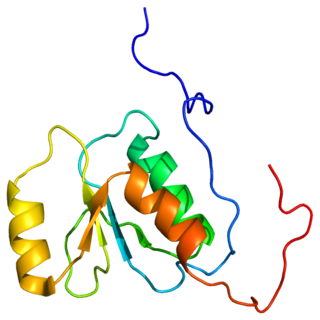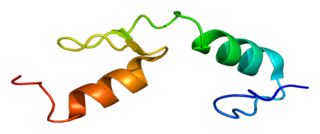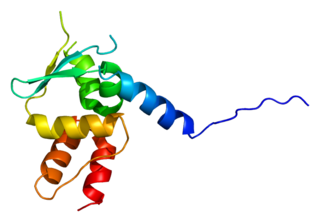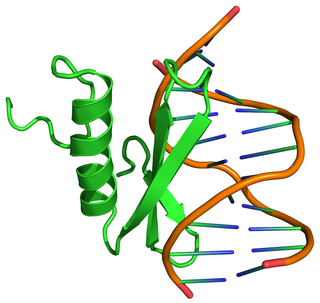Related Research Articles

Deoxyribonucleic acid is a molecule composed of two polynucleotide chains that coil around each other to form a double helix carrying genetic instructions for the development, functioning, growth and reproduction of all known organisms and many viruses. DNA and ribonucleic acid (RNA) are nucleic acids. Alongside proteins, lipids and complex carbohydrates (polysaccharides), nucleic acids are one of the four major types of macromolecules that are essential for all known forms of life.

Genetics is a branch of biology concerned with the study of genes, genetic variation, and heredity in organisms.

James Dewey Watson KBE is an American molecular biologist, geneticist and zoologist. In 1953, he co-authored with Francis Crick the academic paper proposing the double helix structure of the DNA molecule. Watson, Crick and Maurice Wilkins were awarded the 1962 Nobel Prize in Physiology or Medicine "for their discoveries concerning the molecular structure of nucleic acids and its significance for information transfer in living material". In subsequent years, it has been recognized that Watson and his colleagues did not properly attribute colleague Rosalind Franklin for her contributions to the discovery of the double helix structure.

Polymerase chain reaction (PCR) is a method widely used to rapidly make millions to billions of copies of a specific DNA sample, allowing scientists to take a very small sample of DNA and amplify it to a large enough amount to study in detail. PCR was invented in 1984 by the American biochemist Kary Mullis at Cetus Corporation. It is fundamental to much of genetic testing including analysis of ancient samples of DNA and identification of infectious agents. Using PCR, copies of very small amounts of DNA sequences are exponentially amplified in a series of cycles of temperature changes. PCR is now a common and often indispensable technique used in medical laboratory research for a broad variety of applications including biomedical research and criminal forensics.

Moa were nine species of now-extinct flightless birds endemic to New Zealand. The two largest species, Dinornis robustus and Dinornis novaezelandiae, reached about 3.6 m (12 ft) in height with neck outstretched, and weighed about 230 kg (510 lb) while the smallest, the bush moa, was around the size of a turkey. Estimates of the Moa population when Polynesians settled New Zealand circa 1300, vary between 58,000 to c. 2.5 million.

In genetic engineering, a gene gun or biolistic particle delivery system is a device used to deliver exogenous DNA (transgenes), RNA, or protein to cells. By coating particles of a heavy metal with a gene of interest and firing these micro-projectiles into cells using mechanical force, an integration of desired genetic information can be induced into cells. The technique involved with such micro-projectile delivery of DNA is often referred to as biolistics.

A neoplasm is a type of abnormal and excessive growth, called neoplasia, of tissue. The growth of a neoplasm is uncoordinated with that of the normal surrounding tissue, and persists in growing abnormally, even if the original trigger is removed. This abnormal growth usually forms a mass, when it may be called a tumor.

The Carolina dog, also known as a yellow dog, yaller dog, American Dingo, or Dixie Dingo, is a breed of medium-sized, feral dog that lives mostly in the Southeastern United States, especially in isolated stretches of longleaf pines and cypress swamps. Rehoming of Carolina dogs has recently become popular, and they can make good domestic pets with proper socialization. Since 2008, artificial selection efforts to establish them as a standardized breed has made some progress, with recognition in two smaller national kennel clubs, and acceptance into the breed-establishment program of a major one.

Medusozoa is a clade in the phylum Cnidaria, and is often considered a subphylum. It includes the classes Hydrozoa, Scyphozoa, Staurozoa and Cubozoa, and possibly the parasitic Polypodiozoa. Medusozoans are distinguished by having a medusa stage in their often complex life cycle, a medusa typically being an umbrella-shaped body with stinging tentacles around the edge. With the exception of some Hydrozoa, all are called jellyfish in their free-swimming medusa phase.
Ancestry.com LLC is a privately held online company based in Lehi, Utah, United States. The largest for-profit genealogy company in the world, it operates a network of genealogical, historical records, and related genetic genealogy websites.

Coccolithovirus is a genus of giant double-stranded DNA virus, in the family Phycodnaviridae. Algae, specifically Emiliania huxleyi, a species of coccolithophore, serve as natural hosts. There is currently only one species in this genus: Emiliania huxleyi virus 86.

Tissue alpha-L-fucosidase is an enzyme that in humans is encoded by the FUCA1 gene.

Apetala 2(AP2) is a gene and a member of a large family of transcription factors, the AP2/EREBP family. In Arabidopsis thaliana AP2 plays a role in the ABC model of flower development. It was originally thought that this family of proteins was plant-specific; however, recent studies have shown that apicomplexans, including the causative agent of malaria, Plasmodium falciparum encode a related set of transcription factors, called the ApiAP2 family.

DNA-binding protein inhibitor ID-3 is a protein that in humans is encoded by the ID3 gene.

Replication factor C subunit 1 is a protein that in humans is encoded by the RFC1 gene.

Zinc finger protein 40 is a protein that in humans is encoded by the HIVEP1 gene.

Gigaxonin also known as kelch-like protein 16 is a protein that in humans is encoded by the GAN gene.

Transcription factor HIVEP3 is a protein that in humans is encoded by the HIVEP3 gene.

Ethylene-responsive element binding protein(EREBP) is a homeobox gene from Arabidopsis thaliana and other plants which encodes a transcription factor. EREBP is responsible in part for mediating the response in plants to the plant hormone ethylene.
Peter Robert Last is an Australian ichthyologist, curator of the Australian National Fish Collection and a senior principal research scientist at CSIRO Marine and Atmospheric Research (CMAR) in Hobart, Tasmania. He is an elasmobranch expert and has described many new species of shark.
References
| This molecular biology article is a stub. You can help Wikipedia by expanding it. |